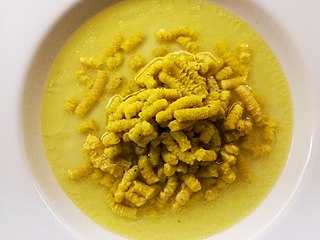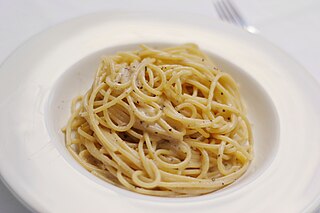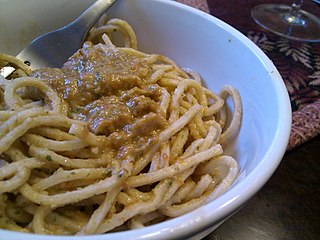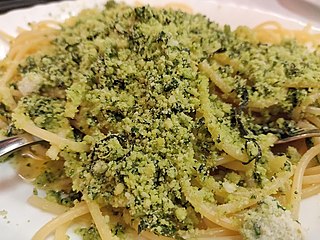
Spaghetti is a long, thin, solid, cylindrical pasta. It is a staple food of traditional Italian cuisine. Like other pasta, spaghetti is made of milled wheat, water, and sometimes enriched with vitamins and minerals. Italian spaghetti is typically made from durum-wheat semolina. Usually the pasta is white because refined flour is used, but whole wheat flour may be added. Spaghettoni is a thicker form of spaghetti, while spaghettini is a thinner form. Capellini is a very thin spaghetti, while vermicelli refers to intermediate widths, varying between the United States and Italy.

Carbonara is a pasta dish made with eggs, hard cheese, fatty cured pork, and black pepper. It is typical of the Lazio region of Italy. The dish took its modern form and name in the middle of the 20th century.

In Italian cuisine, ragù is a meat sauce that is commonly served with pasta. An Italian gastronomic society, Accademia Italiana della Cucina, documented several ragù recipes. The recipes' common characteristics are the presence of meat and the fact that all are sauces for pasta. The most typical is ragù alla bolognese. Other types are ragù alla napoletana, ragù alla barese, ragù alla veneta, and so on.

Arrabbiata sauce, known in Italian as sugo all'arrabbiata, is a spicy sauce for pasta made from garlic, tomatoes, and dried red chili peppers cooked in olive oil. The sauce originates from the Lazio region of Italy, and particularly from the city of Rome.

Spaghetti alla puttanesca is a pasta dish invented in Naples in the mid-20th century and made typically with tomatoes, olive oil, olives, anchovies, chili peppers, capers and garlic, with vermicelli or spaghetti.

Guanciale is an Italian salt-cured meat product prepared from pork jowl or cheeks. Its name is derived from guancia, 'cheek'. Its rendered fat gives flavor to and thickens the sauce of pasta dishes.

Spaghetti and meatballs is an Italian-American pasta dish consisting of spaghetti, tomato sauce and meatballs.

Bigoli is an extruded pasta in the form of a long and thick strand. Initially bigoli were made with buckwheat flour, but are now more commonly made with whole-wheat flour, and sometimes include duck eggs. The preparation is then extruded through a bigolaro, from which the pasta gets its name.

Passatelli are a pasta formed of bread crumbs, eggs, grated Parmesan cheese, and in some regions lemon, and nutmeg; it is typically cooked in chicken broth. Typically, it is found mainly in Romagna, Pesaro and Urbino province, Ancona province and other regions of Italy, such as Umbria.

Marinara sauce is a tomato sauce usually made with tomatoes, garlic, herbs, and onions. Variations include capers, olives, spices, and a dash of wine. Widely used in Italian-American cuisine, it is known as alla marinara in Italy, where it is typically made with tomatoes, basil, olive oil, garlic and oregano, but also sometimes olives, capers, and salted anchovies. It is used for spaghetti and vermicelli, but also with meat or fish.

Spaghetti aglio e olio is a pasta dish typical of the Italian city of Naples. It is a typical dish of Neapolitan cuisine and is widely popular. Its popularity can be attributed to it being simple to prepare and the fact that it makes use of inexpensive, readily available ingredients that have long shelf lives in a pantry.

Cacio e pepe is a pasta dish typical of the Lazio region of Italy. Cacio e pepe means 'cheese and pepper' in several central Italian dialects. In keeping with its name, the dish contains grated pecorino romano and black pepper, together with tonnarelli or spaghetti. All the ingredients keep well for a long time, which made the dish practical for shepherds without fixed abode. Rough-surfaced pasta is recommended to make the sauce adhere well.

Maltagliati, also known as puntarine, are a type of pasta typical of the Emilia-Romagna region of Italy. In the manufacture of pasta such as tagliatelle, dough is rolled and then cut into thin strips, producing noodles. The excess parts of the dough, generally the edges, are left with irregular shape and thickness, therefore "poorly cut" or, in Italian, maltagliati. Maltagliati are therefore cut from such scrap pieces of pasta, and differ in shape, size and thickness.

Paccheri is a type of pasta in the shape of a very large tube, originating from the Campania region of Italy. They are generally smooth, but there is also a ribbed version, paccheri millerighe. The name comes from Neapolitan paccharia, 'slaps', with a depreciative -ero to indicate something common. The name has been ascribed to a slapping sound they may make when eaten. They can be served stuffed.

Pesto alla trapanese is a Sicilian variation of pesto, typical of the province of Trapani. It is also known as pesto trapanese and pesto alla siciliana, and as pasta cull'agghia in the Sicilian language. It is made of garlic, basil, almonds, grated pecorino siciliano, tomatoes, salt, and black pepper, and bound with extra virgin olive oil.

Ciceri e tria is a pasta dish originating in the Salento region. It is prepared with pasta and chickpeas as primary ingredients, and includes fried pasta. It has been described as a "classic and emblematic dish of Salentine cuisine" and as a specialty dish of Apulia.

Pasta alla gricia is a pasta dish originating in the Lazio region of Italy.

Spaghetti alla carrettiera is a pasta dish originating in the Platani Valley, nowadays more common in eastern Sicily. It is generally made with spaghetti, garlic, chili pepper, pecorino siciliano or breadcrumbs, parsley, and olive oil for dressing, and commonly tomato is added. Sometimes additional ingredients such as anchovies, capers, almonds or pine nuts and white wine are also included. The oral tradition is that the pasta dish originated with carters who brought the dish prepared in advance, on their wagons for lunch.


















